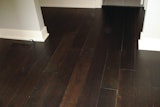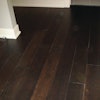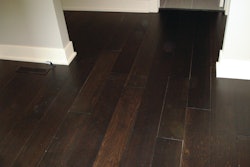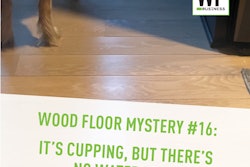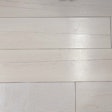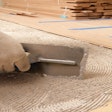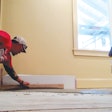The Problem
Four weeks after moving into a new home, the owner began to notice some gaps, ripples, popping and up-and-down movement in her 3-inch, factory finished engineered wood floor. As the disagreement grew between the home owner, builder, installer and distributor, I was called in to determine who and what were responsible for the failing floor.
The Procedure
The wood floor was installed in a house in a new tract-home subdivision in North Carolina. The installation was done in a new home over on-grade concrete. The contractor used his usual adhesive, and the job was completed during summer. The home sat unsold for 45 days. During this time, the home was allowed to sit empty, with no air conditioning or air movement.
Problems began after the home owner moved in. Several weeks after she turned on the air conditioning, the floor began to show gaps and make noise.
The Cause
Many things immediately spring to mind when inspecting a floor such as this one. Was a moisture test done on the concrete? Which adhesive and trowel were used? What were the job-site conditions when the floor was installed? After talking to the wood flooring contractor and doing an inspection of the job site, I discovered several important factors:
- No concrete subfloor test was done.
- The adhesive used was one the contractor "always uses," but it was not one recommended by the manufacturer of the flooring.
- A piece of flooring removed revealed that a very small trowel notch was used, and this resulted in only about 30 to 35 percent transfer of the adhesive to the flooring. Bad transfer allows the wood flooring to move on top of the subfloor, often making the floor noisy. The installer didn't read the recommend spread rate on the adhesive.
- Because the house was allowed to sit for 45 days in the summer heat with no air movement, the construction moisture was not allowed to escape. Therefore, the relative humidity in the home was increased, resulting in a swelling floor. This is commonly known in the trade as the "greenhouse effect." When the home owner moved in and the air conditioning went on, the relative humidity took a nosedive, and the floors shrank. When the floors shrank, gaps between boards appeared, and the shrinkage also allowed excessive movement in the floor, creating noises when someone walked across the floor.
How to Fix the Floor
Unfortunately for all involved, there is no way to save this installation. The floor must be removed, the subfloor cleaned and a new floor installed under the proper conditions—all at the contractor's expense.
In the Future
Some contractors assume that because factory-finished engineered flooring is so much more stable than a solid product, they don't have to bother with some of the details they are used to with job-site finished floors. But, as this job and others like it show, factory-finished engineered floors are not impervious to contractor mistakes. It may sound obvious, but contractors should always read the flooring directions before using them as a dustpan. Many things can be done to prevent more costly mistakes such as this one.
First, always test the subfloor, whether it is wood or concrete, for acceptable moisture levels. Manufacturers of 3-inch engineered products have specific recommendations for the job-site conditions acceptable for installation of their products. General guidelines dictate that wood flooring should never be installed over a slab that is less than 30 days old. After those 30 days, there are many ways a slab can be tested, including a moisture meter, a polyfilm test, or a phenolphthalein test. If one of those tests show a problem, a calcium chloride test should be performed.
Next, use only an adhesive recommended by the flooring manufacturer. As with many other habits, you may get away with using a non-recommended adhesive for many jobs, but eventually it will catch up with you.
It is futile to use the correct adhesive without the correct trowel notch for the adhesive. Trowel specifications are listed in the instruction sheets that come with the wood flooring and are also listed in the directions on adhesive labels. Manufacturers have good reasons for recommending specific trowels for specific products. Trowel size affects both spread rate and dry time, and the recommended notch makes the adhesive perform like it is supposed to.
Remember that a wood floor has roughly the same comfort zone as a human: a relative humidity range of 30 to 50 percent, and temperature between 60 and 80 degrees Fahrenheit. A home left with no air movement can and will cause problems for all types of products—from sheetrock to cabinets—throughout the home.
Don Conner is vice president of technical services for Johnson City, Tenn.-based wood flooring manufacturer Harris-Tarkett.










